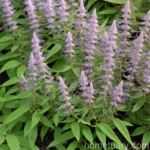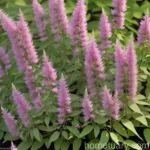The Wonderful Little Volcano Bush Clover (Lespedeza thunbergii subsp. thunbergii ‘Little Volcano’)
Introduction
Plants are fascinating organisms that form the basis for all life on earth. They come in an incredible diversity of shapes, sizes, and functions. In this article, we will delve into the intriguing world of the little volcano bush clover, scientifically known as Lespedeza thunbergii subsp. thunbergii ‘Little Volcano’. This beautiful and versatile plant has garnered much attention due to its unique characteristics and uses. We will explore its cultural requirements, uses, care tips, propagation methods, and more. Whether you are a seasoned gardener or a beginner, there’s much to learn and appreciate about this remarkable plant.
What is Little Volcano Bush Clover (Lespedeza thunbergii subsp. thunbergii ‘Little Volcano’)?
The little volcano bush clover, or Lespedeza thunbergii subsp. thunbergii ‘Little Volcano’, is a splendid deciduous shrub native to East Asia, particularly Japan and Korea. Its captivating appearance, with gracefully arching branches adorned with bountiful clusters of tiny flowers, makes it a prized ornamental plant in gardens and landscapes.
This plant belongs to the Fabaceae family and is part of the Lespedeza genus, which encompasses around 40-60 species of flowering plants. The ‘Little Volcano’ variety is particularly cherished for its compact size and stunning visual appeal.
Key Takeaways – Little Volcano Bush Clover (Lespedeza thunbergii subsp. thunbergii ‘Little Volcano’)
- Scientific Name: Lespedeza thunbergii subsp. thunbergii ‘Little Volcano’
- Family: Fabaceae
- Native Habitat: East Asia, mainly Japan and Korea
- Characteristics: Deciduous shrub with gracefully arching branches and clusters of tiny flowers
Now that we have a basic understanding of this wonderful plant, let’s delve deeper into its cultural requirements and uses.
Culture
Water
Little volcano bush clover generally prefers well-draining soil and thrives in moderate moisture levels. It’s essential to ensure the plant receives adequate watering, especially during dry periods. However, it’s crucial to avoid overwatering, as excessive moisture can lead to root rot and other issues.
Sunlight
When it comes to sunlight, this plant flourishes in full sun to partial shade conditions. In regions with scorching summers, providing some afternoon shade can be beneficial. However, in cooler climates, full sun exposure is typically ideal for robust growth and abundant flowering.
Fertilizer
For optimal growth and blooming, little volcano bush clover benefits from a balanced, general-purpose fertilizer. Applying a slow-release granular fertilizer in early spring, just as new growth emerges, can provide the necessary nutrients for healthy development. Further applications during the growing season can sustain the plant’s vigor and floral display.
Soil
This plant prefers well-drained, fertile soil with a slightly acidic to neutral pH. Amending the soil with organic matter, such as compost or well-rotted manure, can enhance its texture and nutrient content. Good soil preparation during planting is essential for setting the stage for the plant’s long-term health and vitality.
Uses
Ornamental Value
The little volcano bush clover is primarily valued for its ornamental attributes. Its cascading form, coupled with an abundance of small, pea-like flowers, adds a touch of elegance to any garden or landscape. The plant’s delicate green foliage further enriches its visual appeal, especially when it undergoes its splendid fall color transformation.
Wildlife Habitat
In addition to its aesthetic charm, this plant contributes to supporting local ecosystems. The nectar-rich flowers attract various pollinators, including bees, butterflies, and other beneficial insects. Furthermore, the plant’s seeds serve as a food source for birds and small mammals, adding to its ecological significance.
Erosion Control
Due to its fibrous root system and adaptability to various soil types, the little volcano bush clover can be employed in erosion control and stabilization measures. Its ability to thrive in challenging conditions makes it a valuable asset in landscape restoration and soil conservation projects.
Pruning
Proper pruning is essential to maintain the little volcano bush clover’s attractive form and encourage prolific flowering. Pruning should ideally be conducted in late winter or early spring, before new growth emerges. Here are some key pruning tips:
- Remove Dead or Diseased Wood: Start by eliminating any dead, damaged, or diseased branches to promote overall plant health.
- Thinning: Lightly thinning out the older wood can enhance air circulation and light penetration, mitigating disease and encouraging vigorous new growth.
- Shape Maintenance: Regularly shaping the plant to maintain its graceful form and prevent it from becoming too dense is crucial for its visual appeal.
Propagation
The little volcano bush clover can be propagated through various methods, including:
-
Softwood Cuttings: Propagation through softwood cuttings taken in late spring or early summer can be quite successful. These cuttings should ideally be around 4-6 inches long and should root within a few weeks when provided with adequate moisture and warmth.
-
Division: Dividing mature clumps of the plant during the early spring is another effective propagation method. This process not only yields new plants but also revitalizes the parent plant by promoting fresh growth.
Container Popularity
The little volcano bush clover’s moderate size and graceful form make it a popular choice for container gardening. Whether on patios, balconies, or outdoor living spaces, this plant adds a touch of natural elegance to any container arrangement. Its adaptability to diverse soil mixes and relatively low maintenance requirements further enhance its appeal for container gardening enthusiasts.
Common Diseases
Just like any other plant, the little volcano bush clover is susceptible to certain diseases and health issues. Being aware of these potential ailments can help in early detection and appropriate intervention. Some common diseases that may affect this plant include:
-
Powdery Mildew: This fungal disease can manifest as a powdery white coating on the plant’s leaves, usually caused by poor air circulation and high humidity levels.
-
Leaf Spot: Leaf spot diseases, often caused by fungal pathogens, can lead to the development of unsightly spots on the plant’s foliage, potentially compromising its overall health.
-
Root Rot: Excessive soil moisture, especially in poorly drained conditions, can lead to root rot, potentially causing wilting, yellowing leaves, and overall decline.
Disease Diagnosis
Diagnosing plant diseases can be a challenging task, especially for inexperienced gardeners. However, some common signs and symptoms can provide valuable clues:
-
Visual Inspection: A thorough examination of the plant’s leaves, stems, and overall appearance can offer insight into its health. Look for any abnormal discoloration, spots, or deformities.
-
Soil Assessment: Checking the soil for excessive moisture, unusual odors, or signs of decay can help in diagnosing diseases such as root rot.
-
Professional Consultation: In cases of uncertainty or severe symptoms, seeking advice from a plant health specialist or botanist can be crucial in accurately diagnosing and addressing the issue.
Common Pests
Several pests may pose a threat to the little volcano bush clover’s health and vitality. Vigilance and proactive pest management are essential in preserving the plant’s well-being. Some common pests to watch out for include:
-
Aphids: These small, sap-sucking insects can colonize the plant’s tender shoots and foliage, leading to wilting and distorted growth.
-
Leafhoppers: These agile insects can cause damage by feeding on the plant’s sap and potentially transmitting disease-causing pathogens.
-
Caterpillars: Certain caterpillar species may feed on the plant’s foliage, leading to defoliation and reduced vigor.
Botanist’s Tips
Understanding the unique needs and characteristics of the little volcano bush clover is crucial for successful cultivation. Here are some valuable tips from botanists and horticultural experts:
-
Plant Placement: Ensure the plant is situated in a location that provides adequate sunlight and good air circulation, which can contribute to its overall health and vigor.
-
Regular Monitoring: Regularly inspect the plant for signs of pests, diseases, or nutrient deficiencies. Early detection can significantly improve the chances of successful intervention.
-
Educational Resources: Utilize reputable botanical resources, online forums, and local gardening communities to broaden your understanding of this plant and its care requirements.
Fun Facts
- The little volcano bush clover’s botanical name, Lespedeza, honors the Spanish botanist Vicente Cervantes de Lespedez, who lived in the 18th century.
- In its native regions, the plant is often admired for its resilience in challenging environmental conditions and is celebrated in local folklore and traditions.
Links to External Resources
For more in-depth information on little volcano bush clover and related topics, consider exploring the resources provided below:
- Royal Horticultural Society – Lespedeza thunbergii ‘Little Volcano’
- Missouri Botanical Garden – Lespedeza thunbergii ‘Little Volcano’
- North Carolina State University – Lespedeza spp.
- American Horticultural Society – Lespedeza thunbergii
- The Plant List – Lespedeza thunbergii ‘Little Volcano’
In conclusion, the little volcano bush clover (Lespedeza thunbergii subsp. thunbergii ‘Little Volcano’) stands as a testament to the remarkable diversity and beauty of the plant kingdom. Its cultural versatility, ornamental value, and ecological significance make it a plant worthy of admiration and careful cultivation. By understanding and honoring its unique requirements, we can foster its growth and contribute to the preservation of this wonderful species.
The article provides a comprehensive overview of the little volcano bush clover, encompassing its cultural requirements, uses, care tips, propagation methods, and more. By delving into the intricacies of this remarkable plant, we aim to provide a valuable resource for plant enthusiasts and gardeners seeking to enhance their knowledge and appreciation for the natural world. If you have any further questions or need more information, feel free to reach out or explore the provided external resources for additional insights. Keep exploring the wonders of the plant kingdom, and may your gardening endeavors be filled with beauty and abundance!















